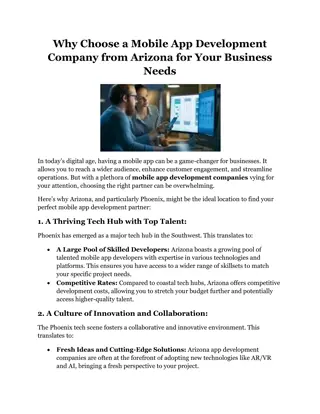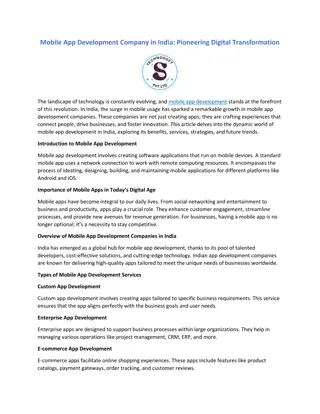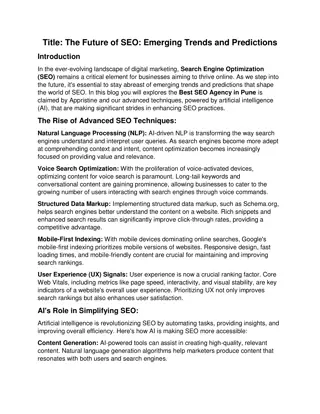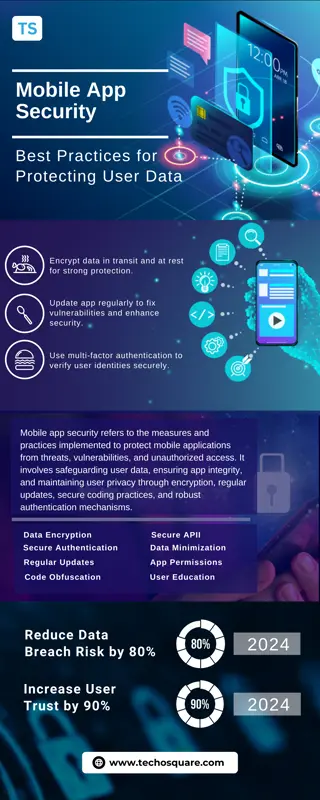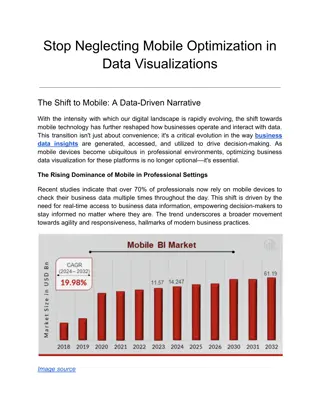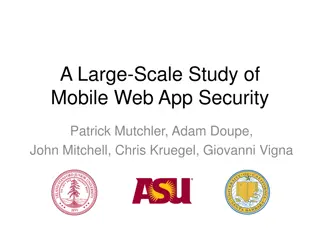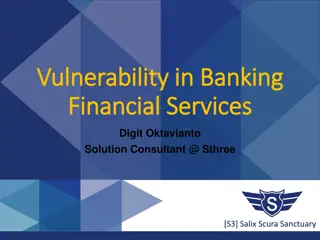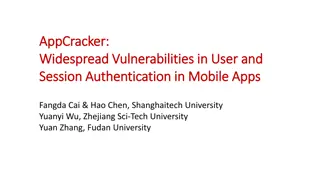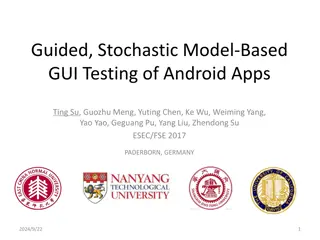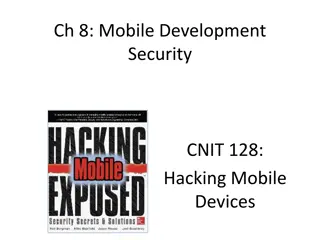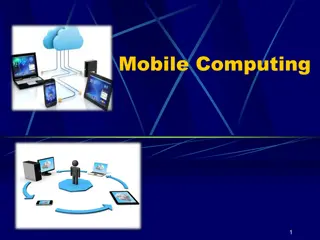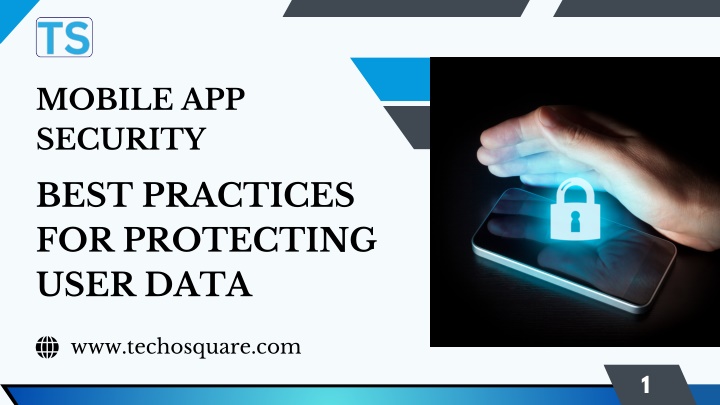
Mobile App Security: Best Practices for Protecting User Data
In the current creator-dependent world, application security on mobile devices has never been more significant. The developers of mobile applications should ensure enhanced security since cyber threats are rapidly changing. At TechoSquare, we not onl
Uploaded on | 1 Views
Download Presentation

Please find below an Image/Link to download the presentation.
The content on the website is provided AS IS for your information and personal use only. It may not be sold, licensed, or shared on other websites without obtaining consent from the author. If you encounter any issues during the download, it is possible that the publisher has removed the file from their server.
You are allowed to download the files provided on this website for personal or commercial use, subject to the condition that they are used lawfully. All files are the property of their respective owners.
The content on the website is provided AS IS for your information and personal use only. It may not be sold, licensed, or shared on other websites without obtaining consent from the author.
E N D
Presentation Transcript
MOBILE APP SECURITY BEST PRACTICES FOR PROTECTING USER DATA www.techosquare.com 1
INTRODUCTION In the current creator-dependent world, application security on mobile devices has never been more significant. The developers of mobile applications should ensure enhanced security since cyber threats are rapidly changing. At TechoSquare, we not only design feature-rich, user-friendly implement best practices in mobile app security to protect user information and build trust. In this blog, we'll discuss essential security practices that need to be integrated during the mobile app development process to ensure effective user data protection. mobile apps but also 2
UNDERSTANDING MOBILE APP SECURITY Mobile Application Security goes on to elaborate on protecting the application from outsider threats that can cause data breaches, and financial loss, as well as prevent a company from damaging its reputation. This encompasses a range of practices from secure coding to encryption and user authentication. Besides, cyber theft has become wiser. And it is increasingly important to get proactive and take a comprehensive approach to security. 3
BEST PRACTICES FOR MOBILE APP SECURITY SECURE CODING PRACTICES INPUT VALIDATION CODE OBFUSCATION TechoSquare prioritizes secure coding practices to safeguard mobile applications and prevent vulnerabilities. Validate any user input to avoid injection attacks such as SQL injection and cross-site scripting (XSS). Obfuscate code so that attackers will not understand the logic of this application through its back-engineering. Never hardcode sensitive information like API keys or passwords in the code. Use secure storage mechanisms instead. By applying these practices, we can avoid potential vulnerabilities in the app code. 4
STRONG AUTHENTICATION AND AUTHORIZATION The main security features of a mobile app include authentication and authorization. Authentication is the process through which the identity of a user of the mobile app is verified to assert that they are who they say they are, while authorization identifies the actions a user is allowed to undertake within the mobile app. TechoSquare has the following strategies in place: 5
MULTI-FACTOR AUTHENTICATION OAUTH AND OPENID CONNECT ROLE-BASED ACCESS CONTROL Implementation of standards-based protocols, including OAuth and OpenID Connect, go a long way in aiding a secure authentication and authorization mechanism of the end user. Develop MFA as an additional security layer that enforces at least two verification factors used by a user to enter an application. In this model of RBAC, a user would be given access to resources provided with the capacity to take action, without exception, if he is appropriately authorized. 6
DATA AT REST AND IN TRANSIT ENCRYPTION Data encryption applied to data at rest and data in transit are basic ways of securing data. SensibleTech makes sure encryption is carried out on all the data of the susceptibilities with robust encryption algorithms. Data at Transmit Protect data during transmission using SSL or TLS to prevent interception by attackers. Data-at-Rest: Advanced encryption standard on all sensitive data saved within the device. It means, among other things, that the data is safe in terms of compromise, even when the device is lost or stolen. 7
PERIODIC SECURITY TESTS AND VULNERABILITY SCANNING Regular security tests are necessary to point out possible vulnerabilities and secure them to prevent hackers from exploiting them. TechoSquare engages in the testing activities given here. 8
Static Application Security Testing (SAST): Analysis of application source code to find security vulnerabilities during development Dynamic Application Security Testing: This uses testing a developed application in a runtime environment to find weaknesses that can result in execution Penetration Testing: This activity engages in simulating attacks on the application to find potential exposure that malicious hackers could easily take advantage of. 9
SECURE APIS APIs are very necessary for the working of any mobile application. Still, there stands the risk of vulnerability if the APIs are not well-secured. At TechoSquare, integrating API gateways helps manage and secure API traffic. Rate Limiting: Rate limiting should be used to prevent potential abuse and denial-of- service attacks. Authentication and Authorization: Ensure that any API request is well authenticated and authorized before the data can be used. 10
UP-TO-DATE LIBRARIES AND FRAMEWORKS Third-party libraries and frameworks indeed help in the rapid development of an application, but they also, if not managed properly, can accommodate security vulnerabilities. Let's see how TechoSquare ensures this: Updating Regularly: All the libraries and frameworks should be updated with the latest security patches. Vulnerability Scanning: Vulnerability scanning through tools for known vulnerabilities in third-party component MCU. 11
THANK YOU If you have any questions, feel free to reach out to us. T Y hank ou! Contact Us +91 (172) 4639432 www.techosquare.com







